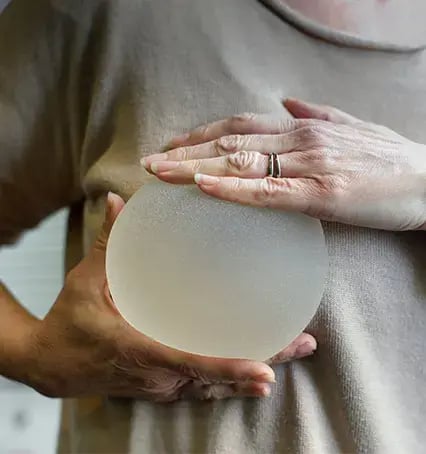What are Inverted Nipples?
What Does It Mean If Your Nipple is Inverted?
Inverted nipples, also known as nipple inversion or retracted nipples, are nipples that are pulled inward instead of pointing outward. Normally, nipples protrude outwards, but in some individuals, one or both nipples may be inverted. This can be a natural variation in breast anatomy and is relatively common, affecting about 10-20% of individuals. There are different degrees of nipple inversion:
1. Grade 1: The nipple can be easily pulled out and may temporarily protrude, either on its own or with minimal manipulation.
2. Grade 2: The nipple is more deeply retracted and can be pulled out, but it requires some effort.
3. Grade 3: The nipple is severely inverted and cannot be easily pulled out or may not protrude at all.
Nipple inversion can occur due to the shortening or tethering of the milk ducts and connective tissue behind the nipple, which pulls it inward instead of allowing it to naturally project outward.
If someone has inverted nipples from birth and it has always been that way, it is typically considered a normal variant and doesn't necessarily indicate any underlying health issues. However, if someone notices a sudden change in their nipple position or inversion, it could be a sign of an underlying problem, such as a breast infection, inflammation, or in rare cases, breast cancer. In such instances, it is essential to consult a healthcare professional for evaluation and appropriate management.
Inverted nipples can sometimes pose challenges for breastfeeding, but many individuals with inverted nipples can successfully breastfeed. In some cases, using techniques like breast shells or nipple suction devices may help draw out the nipples before breastfeeding.
If someone is concerned about their inverted nipples or experiences any unusual changes, they should seek medical advice for proper evaluation and guidance.
Our mission is to create a world where every investment in modern beauty is Worth It.
Let's keep in touch
Get updates of the treatments you are interested
Who Does It Affect? What Causes Inverted Nipples?
Inverted nipples can affect both men and women, and they are relatively common. It is estimated that around 10 to 20% of the population may have inverted nipples to some degree. This condition can occur in individuals of all ages and ethnicities. The exact cause of inverted nipples is not always clear, but it can be attributed to several factors:
1. Congenital: In many cases, inverted nipples are present from birth. The connective tissue and muscle fibers in the nipple are responsible for its projection, and in some individuals, these tissues may be shorter, causing the nipple to retract or invert.
2. Developmental: Changes in breast tissue during puberty and breast development can contribute to the development of inverted nipples.
3. Pregnancy and breastfeeding: Hormonal changes during pregnancy and lactation can cause the nipples to become temporarily inverted in some women. However, this usually resolves after breastfeeding is discontinued.
4. Trauma or scarring: Injuries or surgeries to the breast or nipple area can lead to the development of inverted nipples.
5. Infections or inflammation: Inflammation or infections in the breast tissue can affect the structures responsible for nipple projection.
6. Breast conditions: Certain breast conditions, such as mastitis or benign breast tumors, can cause the nipples to become inverted.

What are the Symptoms? How are Inverted Nipples Diagnosed?
Symptoms of Inverted Nipples are:
Appearance
The primary symptom is the nipple's inward appearance. Instead of pointing outward, it may appear flat or dimpled. In severe cases, the nipple may be pulled deeply inward.
Difficulty with Breastfeeding
For some women with inverted nipples, breastfeeding can be challenging as the baby may have difficulty latching onto the nipple properly. However, with proper techniques and support, many women with inverted nipples can breastfeed successfully.
Potential Discomfort
In some cases, inverted nipples may cause discomfort or sensitivity when pressure is applied or due to friction against clothing.
Diagnosis of Inverted Nipples
Diagnosis of inverted nipples can often be done through a simple physical examination by a healthcare professional, such as a gynecologist or a general practitioner. They will visually inspect the breasts and nipples to determine if they are inverted. Typically, nipples are considered inverted if they don't protrude noticeably when stimulated or in response to cold temperatures.
- Grade 1: The nipples can be easily pulled out and may protrude temporarily.
- Grade 2: The nipples can be pulled out, but they tend to retract back inward.
- Grade 3: The nipples are severely inverted and cannot be pulled out manually.
Our mission is to create a world where every investment in modern beauty is Worth It.
Let's keep in touch
Get updates of the treatments you are interested
How are Inverted Nipples Treated? How Do I Get My Inverted Nipples to Stick Out?
If you're looking to treat inverted nipples, here are some approaches that may help:
1. Breast stimulation: Gently massaging or rolling the nipples between your fingers can help stimulate blood flow and may cause temporary protrusion. Doing this regularly might encourage the nipples to stay more prominent over time.
2. Nipple suction devices: There are specialized nipple suction devices available that are designed to help draw out inverted nipples. These devices work by applying gentle suction to the nipple, encouraging it to protrude.
3. Nipple shields or shells: Nipple shields or shells are worn inside the bra and can apply gentle pressure on the areola, coaxing the nipple to come out.
4. Piercing: In some cases, nipple piercing may lead to the nipples protruding more. However, this option should be approached with caution, as it carries risks and is not suitable for everyone.
5. Breastfeeding: For women with inverted nipples, breastfeeding can sometimes help the nipples to naturally protrude. The act of breastfeeding can stimulate the nipple to come out, though it may not work for everyone.
6. Surgical correction: If non-surgical methods do not work or if the condition causes discomfort, self-consciousness, or difficulty with breastfeeding, surgical correction is an option. There are different surgical techniques available depending on the severity of the inversion and the desired outcome. Consulting a plastic surgeon or a specialist in breast surgery can provide you with more information on the available options.
How Can I Reduce My Risk of Getting Inverted Nipples?
Although it's not always possible to prevent inverted nipples entirely, there are some measures you can take to reduce the risk or alleviate the condition:
- Breastfeeding techniques
- Nipple stimulation
- Nipple shields
- Avoiding trauma
- Correct bra size
- Regular breast examinations
- Healthy lifestyle
- Avoid smoking

Do Inverted Nipples Ever Go Away?
When to See Your Healthcare Provider:
- New changes
- Nipple discharge
- Pain or discomfort
- Pregnancy and breastfeeding

Is It Okay to Have Inverted Nipples?
What Does It Mean If Your Nipple is Inverted?
Inverted nipples, also known as nipple inversion or retracted nipples, are nipples that are pulled inward instead of pointing outward. Normally, nipples protrude outwards, but in some individuals, one or both nipples may be inverted. This can be a natural variation in breast anatomy and is relatively common, affecting about 10-20% of individuals. There are different degrees of nipple inversion:
1. Grade 1: The nipple can be easily pulled out and may temporarily protrude, either on its own or with minimal manipulation.
2. Grade 2: The nipple is more deeply retracted and can be pulled out, but it requires some effort.
3. Grade 3: The nipple is severely inverted and cannot be easily pulled out or may not protrude at all.
Nipple inversion can occur due to the shortening or tethering of the milk ducts and connective tissue behind the nipple, which pulls it inward instead of allowing it to naturally project outward.
If someone has inverted nipples from birth and it has always been that way, it is typically considered a normal variant and doesn't necessarily indicate any underlying health issues. However, if someone notices a sudden change in their nipple position or inversion, it could be a sign of an underlying problem, such as a breast infection, inflammation, or in rare cases, breast cancer. In such instances, it is essential to consult a healthcare professional for evaluation and appropriate management.
Inverted nipples can sometimes pose challenges for breastfeeding, but many individuals with inverted nipples can successfully breastfeed. In some cases, using techniques like breast shells or nipple suction devices may help draw out the nipples before breastfeeding.
If someone is concerned about their inverted nipples or experiences any unusual changes, they should seek medical advice for proper evaluation and guidance.
Our mission is to create a world where every investment in modern beauty is Worth It.
Let's keep in touch
Get updates of the treatments you are interested
Who Does It Affect? What Causes Inverted Nipples?
Inverted nipples can affect both men and women, and they are relatively common. It is estimated that around 10 to 20% of the population may have inverted nipples to some degree. This condition can occur in individuals of all ages and ethnicities. The exact cause of inverted nipples is not always clear, but it can be attributed to several factors:
1. Congenital: In many cases, inverted nipples are present from birth. The connective tissue and muscle fibers in the nipple are responsible for its projection, and in some individuals, these tissues may be shorter, causing the nipple to retract or invert.
2. Developmental: Changes in breast tissue during puberty and breast development can contribute to the development of inverted nipples.
3. Pregnancy and breastfeeding: Hormonal changes during pregnancy and lactation can cause the nipples to become temporarily inverted in some women. However, this usually resolves after breastfeeding is discontinued.
4. Trauma or scarring: Injuries or surgeries to the breast or nipple area can lead to the development of inverted nipples.
5. Infections or inflammation: Inflammation or infections in the breast tissue can affect the structures responsible for nipple projection.
6. Breast conditions: Certain breast conditions, such as mastitis or benign breast tumors, can cause the nipples to become inverted.

What are the Symptoms? How are Inverted Nipples Diagnosed?
Symptoms of Inverted Nipples are:
Appearance
The primary symptom is the nipple's inward appearance. Instead of pointing outward, it may appear flat or dimpled. In severe cases, the nipple may be pulled deeply inward.
Difficulty with Breastfeeding
For some women with inverted nipples, breastfeeding can be challenging as the baby may have difficulty latching onto the nipple properly. However, with proper techniques and support, many women with inverted nipples can breastfeed successfully.
Potential Discomfort
In some cases, inverted nipples may cause discomfort or sensitivity when pressure is applied or due to friction against clothing.
Diagnosis of Inverted Nipples
Diagnosis of inverted nipples can often be done through a simple physical examination by a healthcare professional, such as a gynecologist or a general practitioner. They will visually inspect the breasts and nipples to determine if they are inverted. Typically, nipples are considered inverted if they don't protrude noticeably when stimulated or in response to cold temperatures.
- Grade 1: The nipples can be easily pulled out and may protrude temporarily.
- Grade 2: The nipples can be pulled out, but they tend to retract back inward.
- Grade 3: The nipples are severely inverted and cannot be pulled out manually.
Our mission is to create a world where every investment in modern beauty is Worth It.
Let's keep in touch
Get updates of the treatments you are interested
How are Inverted Nipples Treated? How Do I Get My Inverted Nipples to Stick Out?
If you're looking to treat inverted nipples, here are some approaches that may help:
1. Breast stimulation: Gently massaging or rolling the nipples between your fingers can help stimulate blood flow and may cause temporary protrusion. Doing this regularly might encourage the nipples to stay more prominent over time.
2. Nipple suction devices: There are specialized nipple suction devices available that are designed to help draw out inverted nipples. These devices work by applying gentle suction to the nipple, encouraging it to protrude.
3. Nipple shields or shells: Nipple shields or shells are worn inside the bra and can apply gentle pressure on the areola, coaxing the nipple to come out.
4. Piercing: In some cases, nipple piercing may lead to the nipples protruding more. However, this option should be approached with caution, as it carries risks and is not suitable for everyone.
5. Breastfeeding: For women with inverted nipples, breastfeeding can sometimes help the nipples to naturally protrude. The act of breastfeeding can stimulate the nipple to come out, though it may not work for everyone.
6. Surgical correction: If non-surgical methods do not work or if the condition causes discomfort, self-consciousness, or difficulty with breastfeeding, surgical correction is an option. There are different surgical techniques available depending on the severity of the inversion and the desired outcome. Consulting a plastic surgeon or a specialist in breast surgery can provide you with more information on the available options.
How Can I Reduce My Risk of Getting Inverted Nipples?
Although it's not always possible to prevent inverted nipples entirely, there are some measures you can take to reduce the risk or alleviate the condition:
- Breastfeeding techniques
- Nipple stimulation
- Nipple shields
- Avoiding trauma
- Correct bra size
- Regular breast examinations
- Healthy lifestyle
- Avoid smoking

Do Inverted Nipples Ever Go Away?
When to See Your Healthcare Provider:
- New changes
- Nipple discharge
- Pain or discomfort
- Pregnancy and breastfeeding











